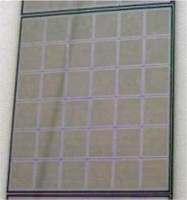SINP scientists take active part in the project of the International Linear Collider (ILC) development. The studies are carried out within the frames of CALICE (CAlorimeter for LInear Collider Experiment) colaboration, which is specialized in the development and testing of the calorimeters prototypes for ILC. Scientific team under the leadership of Mikhail Merkin developed and produced about 400 detecting elements (about 90% from the total number) for the electromagnetic calorimeter prototype. The prototype was tested in the beams at CERN and FermiLab.
The developed prototype of the electromagnetic calorimeter for ILC detector is hetrogenic, i.e. its structure is sandwich-like - the layers of absorbing material take turns with the layers of detecting material. For the first time this idea was proposed by SINP scientists N.L.Grigirov, V.S.Murzin and I.D.Rapoport.
Absorbing material of the calorimeter is tungsten in the form of plates with thickness of 1,4 mm (the most exact front part), 2,8 mm (middle part) and 4,2 mm (the last ten layers for detection of the most high-energetic electromagnetic component). The total radiation length is 24Х0. Advantage of tungsten is that due to its high density large part of energy is absorbed in it, and at the same time Moliere radius (parameter which defines spread of the electromagnetic shower in the material) is low.

Silicaon in the form of cells with size of 1 per 1 cm called detecting elements (see image at the right) is used as detecting material. They were developed and produced in SINP MSU. The advantage of silicon is that besides its weak influence on the particles' parametes, in particular, on the spread of shower due to small thickness, it allows to manufacure more compact calorimeter, because silicon's density if about one thousand times more than density of the gases used as detecting materials. Size of the detecting cell is chosen in a way to separate two neigbour showers steadily even if they are produced by the particles from one and the same decay peak.
In the developed prototype of silicon-tungsten electromagnetic calorimeter absorbing and detecting layers are located perpendicularly to the direction of the falling particle. Falling into the absorbing material the particle interacts with it mainly by means of electromagnetic interaction. It initiates secondary particles production (electrons, positrons and gammas), their excitation and ionization of the medium.
Then in the detecting material the particle does not interact with anything. Here only ionization signal from every charged particle is collected. One detecting element (cell) can detect upto 50 millions particles per second.
In order to get information about direction of the particle's movement and separated energy the detecting material has cells segmentation transversal to the particle's trajectory. Information about the long shape of the shower and on this basis about the type of the particle is obtained due to multi-layer structure of the calorimeter.
As far as secondary particles move deeper into the calorimeter their amount increases. Only some secondary particles can locked in the absorber and do not produce following cascade (shower) of secondary particles.
Prototype of silicon-tungsten electromagnetic calorimeter for ILC detector consists of 30 layers of each material. Total thickness of the prototype is 20 cm. In a complex it provides stopping and absorbtion of all secondary particles and allows to collect and sum up all signals from detecting layers.

